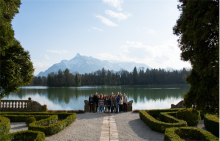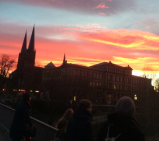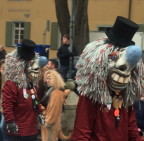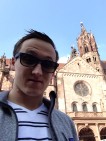
Nach 7,5 Stunden auf der Bahn, die durch die wunderschönen Berge der Alpen schlängelte, erreichten wir das nächste Ziel unserer Reise: Salzburg. Aus dieser neuen Ansicht waren die Höhen des Gebirges noch sichtbar, aber die sind die Kulisse einer pittoresken Landschaft geworden, die von grünen Pflanzen und blühenden Blumen gegeben wurde. Im Vergleich zu Sils Maria, schien es, als ob wir fast in eine ganz andere Jahreszeit eingetreten wären. Die Stadt selber war lebendig und geschäftig. Obwohl Salzburg eine sehr kleine Stadt ist, haben die Geräusche von Vögeln, Verkehr und Leuten mich an Zürich denken lassen. Wie in unserer ersten Stadt wird Salzburg von Hügeln eingebettet, aber hierauf ist die Festung Hohensalzburg seit tausend Jahren gestanden. Als wir aus dem Bahnhof gekommen sind, sahen wir sofort dieses große Kennzeichen, das die Stadt von oben überwacht, und sie schien wie eine Einladung in die Geschichte und Kultur dieser besonderen Stadt.
Nachdem wir unser Gepäck zum Hotel einerseits des Flusses (die Salzach) brachten, hatten wir ein bisschen Zeit, uns von der Bahnfahrt zu erholen. Später haben wir in kleineren Gruppen die Gassen und Straßen der Stadt erkundet. Abends ist die Stadt noch schöner geworden, denn die Dächer und Kirchtürme wurden von Lampen erhellt. Als wir vom Abendessen zurückgekommen sind, brachten wir unseren ersten Tag in Salzburg zum Abschluss.
Der zweite Tag begann früh, denn wir haben viel während unserer kurzen Zeit hier geplant. Nach dem Frühstück gingen wir sofort ins Zentrum der Altstadt. Als Amerikaner konnten wir viele verschiedene Handlungsorte aus dem Film “The Sound of Music” erkennen. Man würde erwarten, dass die Deutschen und Österreicher diesen berühmten Film auch alle gesehen hätten, aber es ist ihnen genauso fremd wie Erdnussbutter; es ist eine Sache aus den USA, die importiert wurde, um Interesse für die Stadt zu erregen. Busse mit der Bezeichnung “The Sound of Music Tour” fuhren an uns vorbei, als wir von dem Salzburg Museum zum Dom gelaufen sind, aber trotz der kommerziellen Herstellung dieses Begriffs, muss man sagen, dass der Regisseur von 20th Century Fox einen guten Geschmack für Landschaft hatte.
Der Film ist nicht das Einzige, was hier zu einer Marke gemacht wurde. Ein Gesicht, das weltweit bekannt ist, ist das von W.A. Mozart. Als sein Geburtsort ist Salzburg unglaublich stolz auf ihren eigenen Musiker, der ein Superstar der Musikwelt geworden ist. Alles von Puppen bis Teegeschirr sind von diesem Mann geprägt. Als wir durch die Stadt liefen, sahen wir viele spezialisierte Geschäfte, die nur diesen Mozart verkauften. Na klar darf man nicht über Salzburg schreiben, ohne eine weltweit beliebte Süßigkeit zu erwähnen: Mozartkugeln, aber man muss auch darauf achten, dass man die Richtigen gefunden hat. Es gibt immer noch einen Streit über wer der ursprüngliche Hersteller des Mozartkugels ist, aber bei mir (und vielen Anderen) ist dieser Hersteller Fürst. Dieser kleineSchatz, der in silbernes und blaues Stanniolpapier verpackt wird, ist wie ein Stück vom Himmel, was man genießen kann, bevor er einen Kaffee gegenüber im Café Tomaselli bestellt.
Der Ruhm dieser Stadt wird von vielen verschiedenen Begriffen wie Musik und Mozart geprägt, aber einer der berühmtesten Teile der Identität, der mir vorher unbekannt war, ist der umfangreiche Einfluss der katholischen Kirche und des Erzbistums. Seit dem 13. Jahrhundert wurde die Stadt von dem Erzbistum geschützt und entwickelt. Noch durch die Reformationszeit erfuhr Salzburg eine Gegenreformation, die die Stadt zu einem katholischen Insel machte, worin sich die Macht der Kirche verstärkte. Die Kultur und Architektur dieser Wurzel ist überall unverwechselbar, und meiner Meinung nach ist diese Vergangenheit ein Grund dafür, dass Salzburg so besonders geworden ist. Eine spannende Geschichte, ein weltweit bekannter Musiker und eine große Kultur einer kleinen Stadt; was gibt’s noch zum Wünschen übrig?







